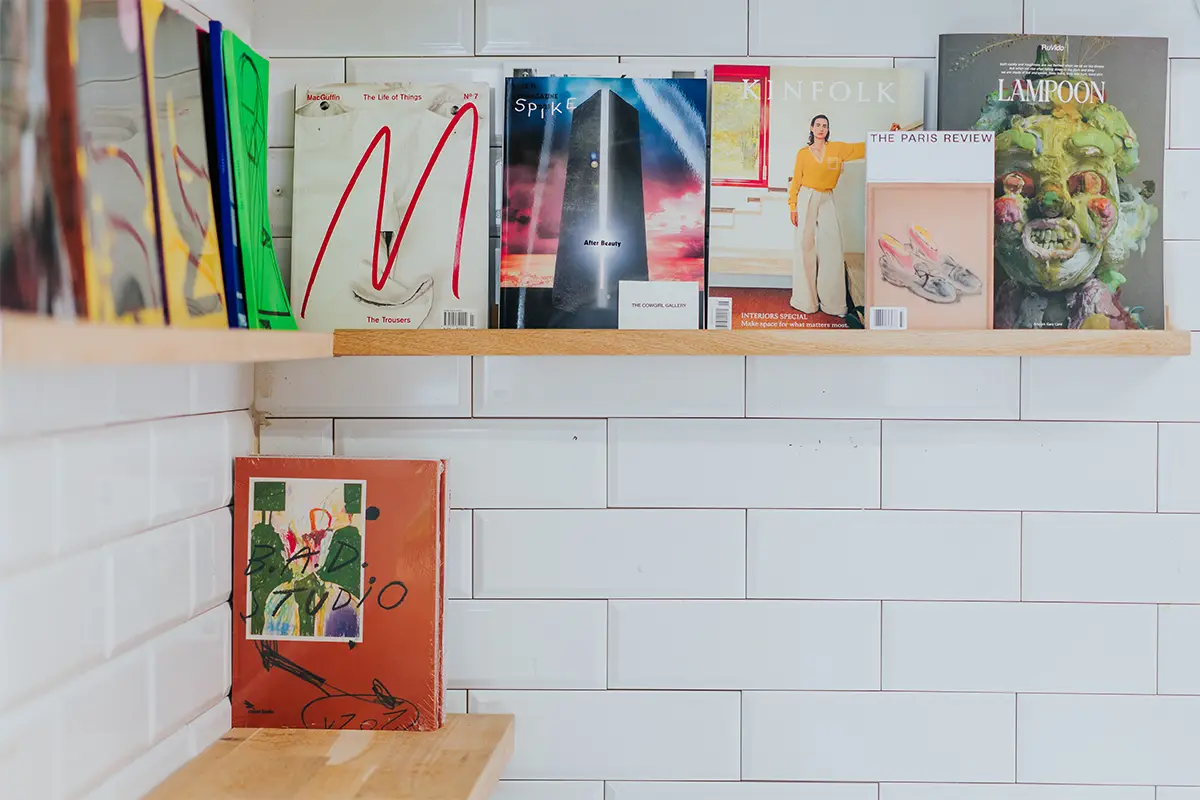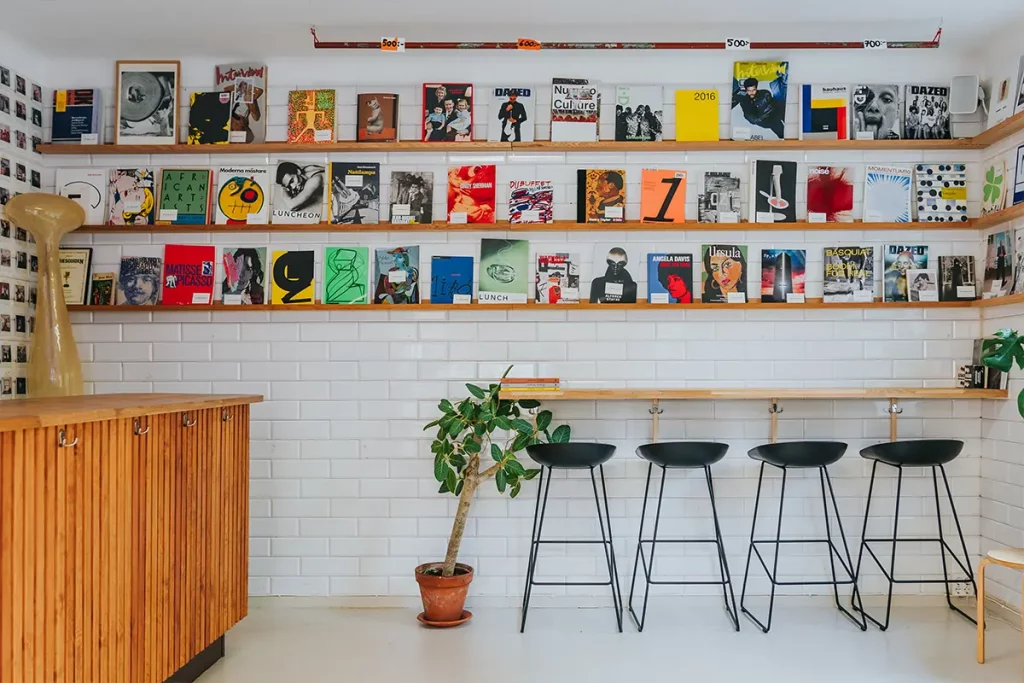«I’m not interested in saving the already saved or showing what’s expected of me or someone else. Art is a universal language that can be spoken by everyone», Selma Modéer Wiking at The Cowgirl Gallery
The Cowgirl Gallery of Malmö: an art gallery, a coffee bar, a cinema club, a hub for live music
Tucked in «a little corner of Malmö», Sweden, is The Cowgirl Gallery. Here, in a brick building from the 1930s, with large windows and an original black and white chess-patterned floor, art and music shows are exhibited, coffee is served and drank, and magazines are bought and displayed. People are also at work and play. «It’s so many different things in one place», says its owner Selma Modéer Wiking.
Founded as «a meeting place for culture and art», where the target audience is literally «everyone»: from 18-year-old queer kids to middle-aged professionals and the elderly, The Cowgirl Gallery was set up with the intention of providing its host city with a space that it was in need of. A space in which everyone was allowed to join the conversation. Speaking to Wiking, she states: «I’m not interested in saving the already saved or showing what’s expected of me or someone else. I think art is a universal language that can be spoken by everyone. By excluding groups, you also exclude the conversation about art, and close the door into the next room. For me it’s not about what you’re carrying with you, or what you’re used to seeing, but what you’re interested in, and why».
«The art exhibitions, the live music, the poetry readings, the cinema club, the coffee during the day, and also other event openings», all of this was set up with that singular purpose, and all of it is run, single handedly, by Wiking.
Selma Modéer Wiking at The Cowgirl Gallery: a community space supported by one person
Serving as Cowgirl’s owner, curator, barista, shop assistant, communications officer, graphic designer, stock and ticket person – to name a few – Wiking, who founded the gallery in 2021 with cultural support funding from the local council, juggles all parts of this show – from ideation to production (then, cleaning up).
This, like any other 20-hours-a-day role, is not without its challenges and toll; «but», as Wiking explains, «it’s fun. I’ve learned a lot. I get inspired everyday by people walking in. I now have own space where I can change the room whenever I want, or if someone walks in and says they do a fun project, I can just say ‘yes let’s collaborate.’ I don’t have a boss to ask ‘is it okay?’».
Speaking to Wiking though, she makes the point to clarify that whilst she handles the bulk of the load, community support is what keeps the gallery open. Aside from the financial support given by cultural organizations, friends volunteer to assist at times when the gallery is busy.
For all intents and purposes, The Cowgirl Gallery is a community-centered meeting place making efforts to ensure it is available to the community it looks to serve. Free to enter, free to stay.
An inclusive space where art is displayed
Originally a milk store, the gallery’s space itself is a single small room that was converted by Wiking in the two months between stumbling on the property and opening day. In order to put on the itine
rary of events The Cowgirl hosts, it must be modified around the proposed function of the day. This has an impact not only on what Wiking chooses to show, but how she chooses to show it.
On choosing works considering scale, the environment she looks to create, mobility and assembly, and what is going on in the rest of the space, Wiking says: «I always have to keep in mind that during the day people are sitting in the gallery surrounded by the art, so there cannot be large sculptures everywhere, because then people cannot sit down and have a coffee. It cannot be scary stuff, because you should also feel welcome when you walk in. It cannot be too much sound or noise because you should also hear each other. It cannot be things that are very heavy, because when we close, I move everything and put it aside in another room, so everything has to be mobile and move».
The Cowgirl Gallery graphics: «fascination with the western visual expression»
The same consciousness in the spatial and curatorial design is present in the visual identity of Cowgirl. Bold graphics across Instagram, Facebook, flyers, programs, and the web, are worked at (by Wiking) until they communicate to every reach of the gallery’s target audience.
Playfulness is intrinsic to The Cowgirl Gallery. It was called ‘Cowgirl’ because as a name, it was catchy, related to the site’s history, andhit Wiking’s «fascination with the western visual expression»; and when it first opened, Wiking would walk around with cowboy boots and «had that look» — the American West get up, which still remains, but «it’s more fun».
Retaining that element of play whilst ensuring that the visual language is generally accessible and digestible, Wiking draws back to their taste since teenagehood. «My eyes have always been drawn to modern, clear fonts like Helvetica, with strong colors. It could be messy, but the base is quite stable».
Selma Modéer Wiking is conscious of the context in Malmö, Sweden
Of all the details that make Cowgirl, the most ‘mischievous’, are the ‘illegal’ benches that sit underneath the two front windows at either side of the cornered entrance.
There without official license, this offered seating allows people a place to sit and socialize. When community-building is at the front of the Gallery, and its owner is building to make an open space, understanding that in such a space one must «have the possibility to create and talk to other people, getting ideas together», these benches enact the Gallery’s ethos. Speaking of their presence, Wiking says «if it’s closed, it’s still open and you can sit down. If it’s open, you have a bench. Nothing is free in life but a bench».
As the benches stay out, Cowgirl comes in direct communication not only with the people in and of Malmö, but with the socio geography of the city, too. Spatially aware, the benches that peak just where the base concrete of the façade stops, and the brick starts, make enough room to sit and gather without taking up too much space that the sidewalk is rendered inaccessible. The Cowgirl Gallery and Selma Modéer Wiking are conscious of their context in Malmö, Sweden. That The Cowgirl Gallery is there is vital to its existence.
Community building outside Stockholm: «we have no dedicated magazine store in Malmö»
«I sometimes say that Cowgirl will not work somewhere else than Malmö». Citing the city’s low rent prices and cost of living as the main reasons a gallery like this will not be possible for them to open elsewhere, Wiking then goes further to include that the culture here also plays a major role. «Malmö is open. It’s rich in music and art, people and food. So that also makes it a lot easier to open a space where everyone can be».
Despite the cultural richness, Wiking says «we have no dedicated magazine store in Malmö». Other than the two in Stockholm, which she sings the praises of, in Sweden she says, «you have to order online to get interesting stuff».
This is the reason why as of August – two years after opening – she has launched The Cowgirl Magazine Store. Noting that «magazines help to make people inspired in that you are able to browse in them for free, and to hear about what this person in a completely other body than you is doing», Wiking says it is all about exposure and representation. «There are many artists that I cannot exhibit. It’s only one at a time. But that there are thousands of artists in the magazines, that have so many interesting things to say, that’s what the magazines and books are there for».
Wiking’s conviction in the point of printed matter is deep to the point that before the Magazine Store, she will bring in books and magazines from her personal library, to get people involved with them. «I want people to get inspired», she says.
Selma Modéer Wiking about what The Cowgirl Gallery is becoming
It was inspiration that caused The Cowgirl Gallery to exist. Planning to leave Malmö for Berlin, to work with graphic design which she went to art school to study, Wiking randomly came across the little space and took on a new challenge. «When the idea came», inspiration carried; and the same inspiration still carries on days when the space is too small and the «one room needs to be changed».
The Cowgirl Gallery is a space where people come together to work, hang out, exchange ideas and blend. Whilst this can come with pressure and a sense of responsibility, for Wiking, «that just puts wood on my fire».
Keeping the fire burning: sustainable practice at The Cowgirl Gallery
Engaging in sustainable practices, Wiking takes the summer off, every summer, to recharge and find inspiration. «Whether it’s painting, photography, collage, graphic design, performance art, political art, whatever, I think you can never get enough of spaces showing artists, and my favorite places, where I get energy and where I get inspired, is most of the time in galleries or in art museums, or in the cinema. Always the library».
The Cowgirl Gallery, Malmö
The Cowgirl Gallery is a culture hub in the form of an art gallery, a magazine store, and a café, in Malmö, Sweden. Founded in 2021 by Selma Modéer Wiking, it is a state-funded project working to cultivate a culture in which everyone is invited.




















